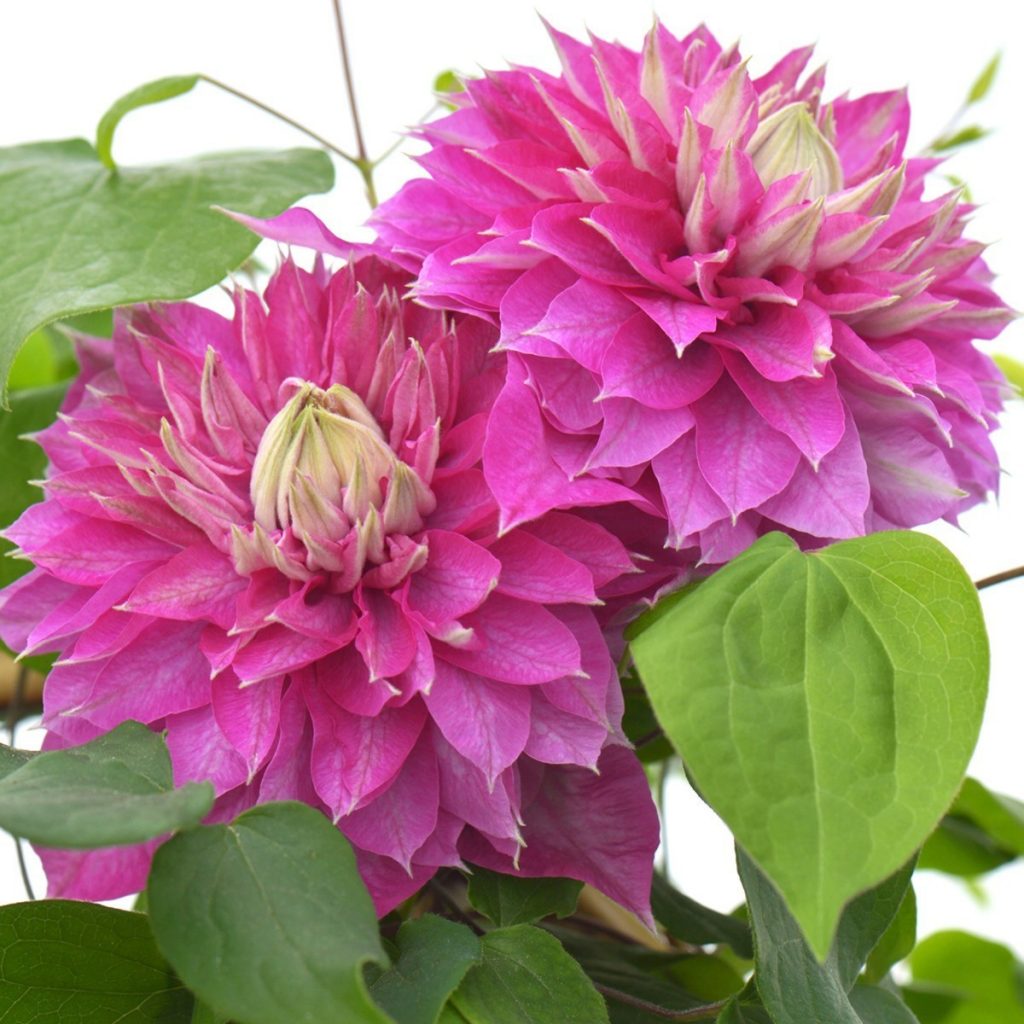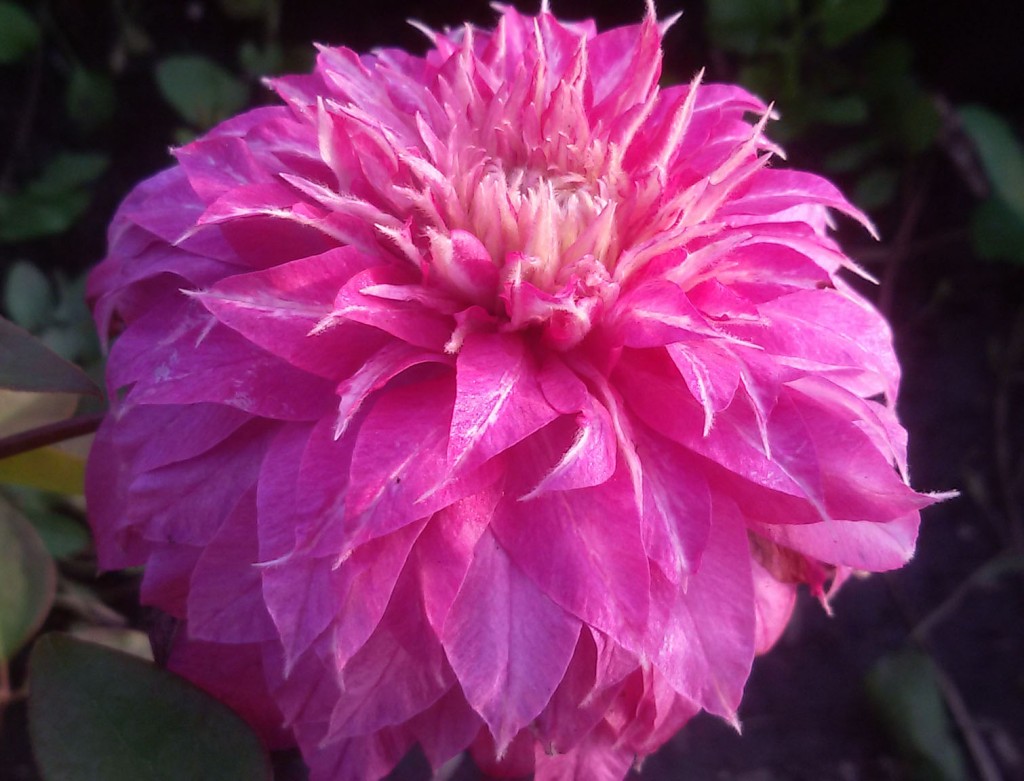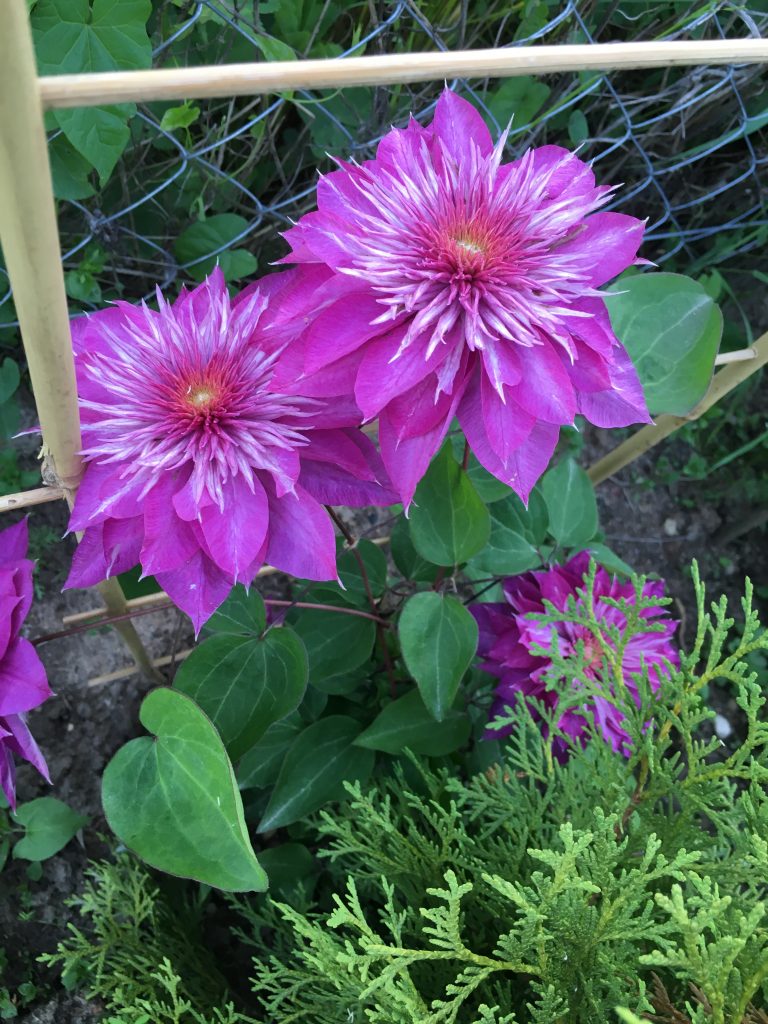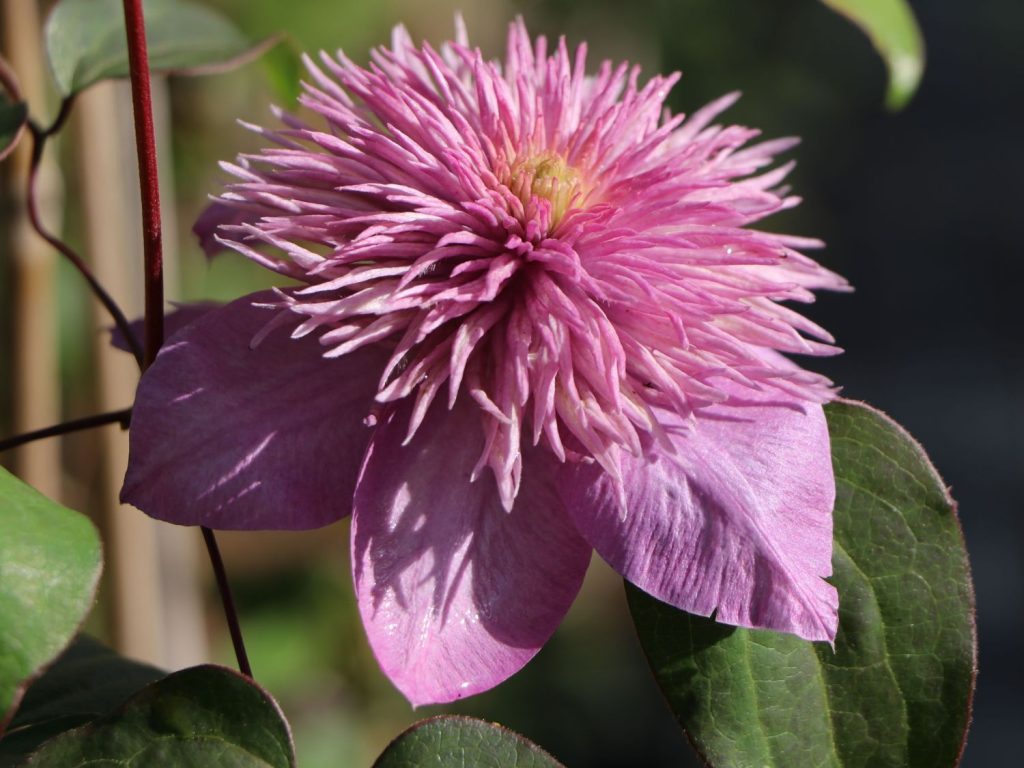Large-flowered Clematis Kaiser is the most unusual variety
Clematis Kaiser is a novelty among hybrids that appeared in Russia only at the end of the first decade of the 21st century. The variety became famous for its bright large inflorescences. It copes well with small frosts, therefore it is more often grown in the regions of the Middle Lane.

Clematis Kaiser description
Varietal characteristics
Clematis belongs to the plant genus of the Buttercup family.
The Kaiser variety (lat.clematis hybriden kaiser) is a large-flowered climbing perennial. It was introduced in Japan in 1997. Originator - F. Miyata & K Miyakazi. In Russia, it began to be sold only since 2010.
Botanical Description:
- the shape of the bush is liana-like, the length of the lianas is up to 1-1.5 m, it is distinguished by the active development of shoots;
- foliage of medium size, elongated ellipsoid shape, with pointed ends, dark green color;
The most attractive thing about this variety is the unusual fluffy flowers. They are multi-row, multi-petal, up to 15 cm in diameter, the core is yellow, the surface of the petals is terry, the color is in shades of pink and purple.
At low temperatures, the purple-pink color changes to light green with white blotches.
The shape of the petals is from wide open to needle-like, the aroma is pronounced.
Flowering takes place on the stems of the past and current year. Falls from the end of May to October, depending on the climatic zone of cultivation, dressing and watering.
Budding has two waves: abundant is observed at the beginning of summer on last year's shoots, reappears in the middle of summer on young shoots, and decreases significantly by autumn.
The life span of a flower culture is up to 25 years.
Landing features
When choosing seedlings, they look at the condition of the roots. The high quality is indicated by the golden yellow color. It is also worth paying attention to labeling. So, the mark "marque" is used for plants in which the root system was cooled before storage, and it is in a moist substrate.

Clematis Kaiser reviews
Clematis are planted in calm and lighted places. The optimal planting time is spring, after the establishment of warm weather, without the threat of recurrent frosts.
Preparatory work
Alkaline or acid-neutral soils are suitable for planting. Clematis grows poorly in heavy clay soils.
A few hours of sunshine a day is enough for them, so the landing site can be chosen not too hot, in partial shade, protected from the through wind.
For the cultivation of the Kaiser variety, it is better to use the eastern and western facades, because the south sides overheat in the direct sun in summer.
When clematis is planted near other ground cover plants, trees and shrubs, they are fenced with a curb tape, which will protect the roots from the encroachments of neighbors on nutrients and water.
Technology
Before planting, the plant is placed in water so that the root system is saturated with moisture.
Technology:
- planting pits are prepared with a depth of 0.5 m at a distance between bushes of 1.5 m or more;
- a week before planting, fill with a nutritious mixture of fatty clay (100-200 g) and rotted humus (1 bucket) and superphosphate (50-100 g);
- when located in places of close occurrence of groundwater, drainage must be organized, pouring gravel or broken brick on the bottom of the holes with a layer of 10-5 cm;
- the seedling is placed in the central part, the roots are straightened and covered with soil, deepening the root collar by 5-10 cm:
- the bush is watered with settled water;
- the soil is mulched with compost, straw or tree bark, spreading around the base;
- for the first time, until the moment of final rooting, the plants are shaded.
Experienced flower growers plant clematis with one pair of buds buried. If for some reason the aboveground part of the bush dies, fresh shoots will grow from the covered buds preserved in the ground.
For the development of all clematis, incl. and Kaiser varieties, a support is required to which they cling with leaf stalks, gradually stretching in length. As a supporting structure, vertical sections, gazebo fences, ropes are suitable. The frequency of the garter to the supports is every 2-3 days. Tied up with fabric strips or fixed with staples.
From spring to autumn, the free space in the pit, formed as a result of soil subsidence as the shoots become lignified, is filled with earth.
Instead of mulching, it is possible to plant perennial bells, heucheras and representatives of liliaceae.
Care rules
The flowering of the Kaiser in accordance with the varietal characteristics is observed only with proper care, including timely watering, fertilizing, weed control, protection from pests and infectious diseases.

Clematis Kaiser care
Watering
Watering has a direct effect on the flowering of clematis. The recommended regime is infrequent moistening with a large volume of water to the depth of root growth, as the surface layer of the earth dries out by 7-10 cm. After a day, the irrigation field is loosened, increasing air permeability for the free supply of oxygen to the root system.
Top dressing
The procedure is carried out regularly, throughout the growing season, with an interval of 7 days. The recommended method of application is in the composition of aqueous solutions by root irrigation.
Ready-made mineral complexes and organics are suitable for fertilization.
Pruning
For Kaiser, active growth of shoots is characteristic, therefore the bush needs regular pruning. Scheme:
- The first pruning is carried out immediately after planting. The seedling is pruned, keeping only 2-4 buds. Such post-plant shortening helps to shorten the rooting time and adaptation of the plant to new growth conditions.
- Secondarily, the bush is formed after a while, leaving no more than 4 buds.
- In the future, in the spring and summer, last year's faded and basal shoots are shortened, without removing only the strongest buds, young shoots are cut off.
- Throughout the summer, the stems are thinned to ensure the free passage of air masses and to avoid the spread of pathogens inside the bush.
- From the second year of life, old shoots are cut out before winter.
If you ignore pruning, the flower culture loses its decorative effect: the inflorescences become smaller.
Pre-winter preparation
In order to avoid freezing of the root system, especially when grown in unfavorable climatic conditions, clematis are insulated for the winter:

Clematis Kaiser planting and care
- when the temperature drops to -3 ° C, the bushes are hardened for 5-7 days, in the absence of a further decrease in the degree;
- later, near the base, a choice of needles, sawdust, dried leaves, sand with ash 10-15 cm thick are poured;
- after the autumn pruning, the plants are covered (with agrofibre, spandbond, polypropylene), arranging several holes for ventilation.
Without shelter, you can grow the variety only in the southern regions or when planting in protected ground.
To protect against severe frosts, a frame is built:
- in the fall, the vines are removed from the supports, shortened and leaves are removed from them;
- the bases of the bush are mulched with sand and wood ash;
- on a dry day, the shoots are folded, laid on the ground and covered with a covering material;
- a wooden structure is placed on top - a box or flooring made of boards;
- the shelter is covered with moisture-proof polyethylene or roofing felt, pressing the edges to the ground, leaving cracks for air to enter;
- with the final onset of frost, coniferous spruce branches or dry foliage and a layer of snow are lined up.
Reproduction methods
Clematis is propagated by cuttings, layering and dividing the bush.
Seed propagation is rarely used, because requires high-quality planting material (in a hybrid, it ripens infrequently) and special conditions. The method is used only for obtaining new varieties.
Cuttings
Reproduction technology by cuttings:
- ripe shoots up to 0.7 m long are cut with a sharp tool;
- remove greens from the top, leaving up to 2-3 buds;
- I cut off large foliage by 1/3;
- the cuttings are placed in an aqueous solution with a root-forming stimulant for an hour, or the lower cut is sprinkled with powder;
- blanks are planted for rooting in loose substrate with a large proportion of sand or vermiculite;
- plantings are covered with plastic wrap in order to create a greenhouse effect.
The shoot takes root in about 2 months.
By dividing the bush
Adult, well-developed plants from two years of age or more are suitable for reproduction by division. More often the bush is divided during transplantation, I cut off the cut with the rhizome and the aerial part. The separated clematis are immediately planted in open ground.
Layers
An adult plant can be propagated by layering - shoots about 0.2-0.3 m long, which are buried and sprinkled with earth, leaving the top on the surface. A weighting agent (for example, a stone) is applied at the location of the internodes. As the layers grow, the soil is filled up, the internodes are pressed.
Treatment and prevention
The greatest danger for the Kaiser is represented by snails and slugs, which eat up the green mass and lead to a loss of decorativeness. In case of violation of care, a nematode, spider mite and aphids may appear on the bushes.

Planting clematis Kaiser
As a preventive measure, the area around the base is sprinkled with wood ash. At the first signs of the appearance of pests, insecticide treatment is carried out. Massively affected bush is subject to uprooting and burning.
Folk preventive remedies:
- from spider mites - spraying with garlic infusions;
- from aphids - treatment with tobacco dust;
- from nematodes - watering the roots with hot water (about 50 ° C).
The cause of all kinds of rot is waterlogging of the soil. Infections of fungal etiology are common:
- alternaria - manifests itself in the form of withering away of foliage and stems;
- powdery mildew - accompanied by the appearance of white spots on vines and a slowdown in development;
- gray rot - a sign is a plaque on the aboveground part formed by fungal spores;
- wilting - the turgor of the shoots is lost and the whole bush dries up.
In the fight against fungal infections, the affected fragments are cut off, and healthy areas are treated with fungicidal preparations - Azocene and Fundazol. Against powdery mildew, it is possible to use soap-based aqueous solutions with copper sulfate. Treatment with copper-containing compounds helps with altenariosis.
Application rules in landscape design
The variety of clematis Kaiser is intended for the improvement of urban and park areas and gardening of personal plots. The use of vines in landscape design is based on growing in a vertical direction on supports, which makes it possible to create hedges, incl. arcade.
Individual bushes are grown in containers, which allows you to move it without damage to the flower.
Often, the variety is used as the central fragment of a garden composition. Clematis of other varieties and climbing roses will be suitable neighbors.

Clematis Kaiser landing
Variety reviews
Many gardeners grow Clematis Kaiser because of its bright bloom with large buds. The flower culture is widely used in landscape design of personal plots and for landscaping urban and park areas. The exotic variety grows well in warm and temperate climates. When planting in suitable soil and organizing care, it is possible to extend the life of the plant up to 25 years.

